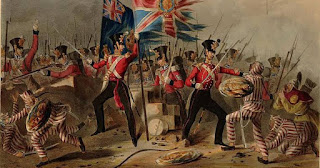MAHALWARI SYSTEM OF LAND REVENUE
•Mahalwari System:----It was implemented in Gangetic valley, north-west provinces, parts of central India and Punjab.
Because in North India and Punjab, joint land rights on the village were common. So, British decided to utilize this traditional structure in a new form known as
• Features:----1. The revenue was determined on the basis of assessment of the produce of a Mahal
(estate consisting of several villages). Here the settlement was made with the whole
village community jointly and separately and taxation was imposed on the village
community.
2. The village community had to distribute these tax collection targets among the
cultivators.
3. Each individual farmer contributed his share in the revenue.
4. Everyone was thus liable for the others’ arrears.
5. But still the ownership rights were vested with the individual peasants thusFarmers had right to sell or mortgage their property.
6. The village community did not necessarily mean entire village population. It was a group of elders, notables of high castes.
7. A village inhabitant, called the Lambardar, collected the amounts and gave to the British.
8. British periodically revised tax rates.
•Consequences:---1. Since Punjab, Northern India had fertile land. So British wanted to extract maximum Revenue out of this region. Land Revenue was usually 50% to 75% of the produce.
2. As generations passed, fathers divided land among sons which resulted in
fragmentation of farms and farms became smaller and smaller thus productivity
declined.But still British demanded Revenue in cash. So, farmers had to borrow money to pay taxes in the case of crop failures.
3. As a result, more and more farms passed into the hands of moneylenders. When
farmer failed to repay debt, Moneylender would take away his farm but he has no
interest in self-cultivation so he would be leasing it to another farmer.
4. Thus, sub-leasing, indebtedness and landlessness became more and more common in Mahalwari region.
Mahalwari was also called Modified Zamindari system because in Mahalwari areas, the Land revenue was fixed for the whole village and the village headman (Larnbardar) collected it. Meaning theoretically Village itself was a landlord/zamindar. Other names for this system were Joint rent, ‘joint lease’, ‘brotherhood’ tract (mahal) holding and ‘gram wari’ etc
Because in North India and Punjab, joint land rights on the village were common. So, British decided to utilize this traditional structure in a new form known as
•land revenue system of British India
"MAHALWARI SYSTEM"in British India• Features:----1. The revenue was determined on the basis of assessment of the produce of a Mahal
(estate consisting of several villages). Here the settlement was made with the whole
village community jointly and separately and taxation was imposed on the village
community.
2. The village community had to distribute these tax collection targets among the
cultivators.
3. Each individual farmer contributed his share in the revenue.
4. Everyone was thus liable for the others’ arrears.
5. But still the ownership rights were vested with the individual peasants thusFarmers had right to sell or mortgage their property.
6. The village community did not necessarily mean entire village population. It was a group of elders, notables of high castes.
7. A village inhabitant, called the Lambardar, collected the amounts and gave to the British.
8. British periodically revised tax rates.
•land revenue system of British India
•Consequences:---1. Since Punjab, Northern India had fertile land. So British wanted to extract maximum Revenue out of this region. Land Revenue was usually 50% to 75% of the produce.
2. As generations passed, fathers divided land among sons which resulted in
fragmentation of farms and farms became smaller and smaller thus productivity
declined.But still British demanded Revenue in cash. So, farmers had to borrow money to pay taxes in the case of crop failures.
3. As a result, more and more farms passed into the hands of moneylenders. When
farmer failed to repay debt, Moneylender would take away his farm but he has no
interest in self-cultivation so he would be leasing it to another farmer.
4. Thus, sub-leasing, indebtedness and landlessness became more and more common in Mahalwari region.
•land revenue system of British India
Mahalwari was also called Modified Zamindari system because in Mahalwari areas, the Land revenue was fixed for the whole village and the village headman (Larnbardar) collected it. Meaning theoretically Village itself was a landlord/zamindar. Other names for this system were Joint rent, ‘joint lease’, ‘brotherhood’ tract (mahal) holding and ‘gram wari’ etc






Comments
Post a Comment